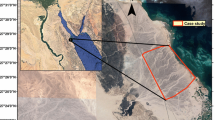Abstract
Highways in arid regions are highly exposed to damage by floods. This requires intensive analysis of flood quantity, time and direction that can be used to design the suitable protection measures. Flood hazard mitigation can be achieved through calculating quantities and distribution by deriving a rainfall–run-off relationship which plays an important role in watershed managements and protection. This study aims to determine the overflow stream ways crosswise over roads and their stream sizes under various precipitation events of 10, 25, 50 and 100 return periods. This can be used in the planning of the flood alleviation measures to protect the roads from flood hazards. This methodology is applied to a real area, Tama road as a part of King Abdul-Aziz Highway, Kingdom of Saudi Arabia. Recorded data were gathered for the study area, and hydrological models were used for delineation of the study area. The results indicated that the proposed site of the new road is extremely exposed to flash flood hazard and protection measures are essential to protect the road. A system of protection is proposed and designed including 7 channels and 2 culverts to mitigate the flood hazard in the area of study. The proposed mitigation system is fit for protecting this area from flood hazards. Protection of such roads helps to save lives of people and reduce the cost of maintenance and rehabilitation due to damages caused by flood.

















Similar content being viewed by others
References
Abd-Elhamid HF, Fathy I, Zeleňáková M (2018) Flood prediction and mitigation in coastal tourism areas, a case study: Hurghada, Egypt. Nat Hazard 93(2):559–576
Abdel Moneim N (2000) Rainfall—runoff relationship in Mountainous area case study Wadi Sudr, M. Sc. Thesis, Faculty of Engineering, Ain Shams University, Cairo, Egypt
Abosuliman S, Kumar A, Alam F (2014) Flood disaster planning and management in Jeddah, Saudi Arabia—a survey. In: International conference on industrial engineering and operations management Bali, Indonesia, 2014
AL Jabari S, Abu Sharkh M, Al-Mim Z (2009) Estimation of runoff for agricultural watershed using SCS curve number and GIS. In: 13th International water technology conference, IWTC, Hurghada, Egypt, pp 1213–1229
Arrighi C, Pregnolato M, Dawson R, Castelli F (2019) Preparedness against mobility disruption by floods. Sci Total Environ 654:1010–1022
Bakir M, Xingnan Z (2008) GIS-based hydrological modelling: A comparative study of HEC-HMS and the Xinanjiang model. IAHS-AISH Publication 319(1):124–133
Chow T, Maidment R, Mays W (1988) Applied hydrology. McGraw-Hill Book Company, New York
Dawod G, Mirza M, Al-Ghamdi K (2011) Assessment of several flood estimation methodologies in Makkah metropolitan area, Saudi Arabia. Arab J Geosci. https://doi.org/10.1007/s12517-011-0405-5
Evangelia G, Chrisoula R, Kleomenis K, Christos C (2013) A GIS-based flash flood runoff model using high resolution DEM and meteorological data. EARSeL eProc 12:33–43
Fathy I, Abd-Elhamid HF, Zelenakova M, Kaposztasova D (2019) Effect of topographic data accuracy on Watershed Management. Int J Environ Res Public Health 16(21):4245
Gissing A, Opper S, Tofa M, Coates L, McAneney J (2019) Influence of road characteristics on flood fatalities in Australia. Environ Hazard. https://doi.org/10.1080/17477891.2019.1609407
Haq M, Akhtar M, Muhammad S, Paras S, Rahmatullah J (2012) Techniques of remote sensing and GIS for flood monitoring and damage assessment: a case study of Sindh province, Pakistan. Egypt. J Remote Sensing Space Sci 15(1):135–141
Jena S, Tiwari K (2006) Modeling synthetic unit hydrograph parameters with geomorphologic parameters of watersheds. J Hydrol 319(1):1–14
Koks E, Rozenberg J, Zorn C, Tariverdi M, Vousdoukas M, Fraser S, Hall J, Hallegatte S (2019) A global multi-hazard risk analysis of road and railway infrastructure assets. Nat Commun 10:2677. https://doi.org/10.1038/s41467-019-10442-3
Liu Y, Chen Z, Wang J, Xu S, Hu B (2011) Fifty-year rainfall change and its effect on droughts and floods in Wenzhou. China Nat Hazard 56(1):131–143
Mihalik E (2007) Watershed characterization and runoff modelling of the Chapel Branch Creek, Orangeburg county, South Carolina, MSC thesis, College of Charleston, USA
Nouh M (2006) Wadi flow in the Arabian Gulf states. Hydrol Process 20(2):2393–2413
Pradhan B (2010) Flood susceptible mapping and risk area estimation using logistic regression, GIS and remote sensing. J Spat Hydrol 9(1):1–18
Pregnolato M, Ford A, Wilkinson S, Dawson R (2018) The impact of flooding on road transport: a depth-disruption function. Transp Res Part D 55:67–81
Rahman M, Aldosary A, Nahiduzzaman K, Reza I (2016) Vulnerability of flash flooding in Riyadh, Saudi Arabia. Nat Hazard. https://doi.org/10.1007/s11069-016-2521-8
Şen Z, Al-Suba’l K (2002) Hydrological considerations for dam siting in arid regions: a Saudi Arabian study. Hydrol Sci J 47(2):173–186
Shalaby N (2006) Hydrology of wadies in Sinai, M. Sc. Thesis, Faculty of Engineering, Ain Shams University, Cairo, Egypt
Silvio J (2013) Interaction between GIS and hydrologic model: a preliminary approach using Arc Hydro framework data model. Ambient Água Interdiscipl J Appl Sci 8(3):83–92
Youssef A, Pradhan B, Sefry S (2014) Remote sensing-based studies coupled with field data reveal urgent solutions to avert the risk of flash floods in the Wadi Qus (east of Jeddah) Kingdom of Saudi Arabia. Nat Hazard 75(1):1465–1488
Youssef A, Sefry S, Pradhan B, Abu AE (2016) Analysis on causes of flash flood in Jeddah city (Kingdom of Saudi Arabia) of 2009 and 2011 using multi-sensor remote sensing data and GIS”. Geomat Nat Hazard Risk 7(3):1018–1042
Yun J, Dong G, Won T, Hai N, Jeong K, Hee C, Hyun B, Ho S, Moo Y (2014) Analysis on runoff characteristics of decentralized rainwater management system using XP-SWMM simulation. In: 11th international conference on hydro informatics, HIC, New York City, USA
Author information
Authors and Affiliations
Corresponding author
Additional information
Publisher's Note
Springer Nature remains neutral with regard to jurisdictional claims in published maps and institutional affiliations.
Rights and permissions
About this article
Cite this article
Fathy, I., Zeleňáková, M. & Abd-Elhamid, H.F. Highways protection from flood hazards, a case study: New Tama road, KSA. Nat Hazards 103, 479–496 (2020). https://doi.org/10.1007/s11069-020-03996-9
Received:
Accepted:
Published:
Issue Date:
DOI: https://doi.org/10.1007/s11069-020-03996-9




